IMAT5262 Research, Ethics & Professionalism in Computing : Assignment
28 Pages4390 Words18 Views
Added on 2021-06-16
IMAT5262 Research, Ethics & Professionalism in Computing : Assignment
Added on 2021-06-16
ShareRelated Documents
MSc
Informatio
n Systems
Manageme
nt
Assignment - Project Proposal
Attacks on Software
through Viruses and
Worms
Pxxxxxxxx
De Montfort
University
DO NOT INCLUDE
YOUR NAME AS THE
WORK WILL BE
IMAT5262 Research,
Ethics &
Professionalism in
Computing
Informatio
n Systems
Manageme
nt
Assignment - Project Proposal
Attacks on Software
through Viruses and
Worms
Pxxxxxxxx
De Montfort
University
DO NOT INCLUDE
YOUR NAME AS THE
WORK WILL BE
IMAT5262 Research,
Ethics &
Professionalism in
Computing
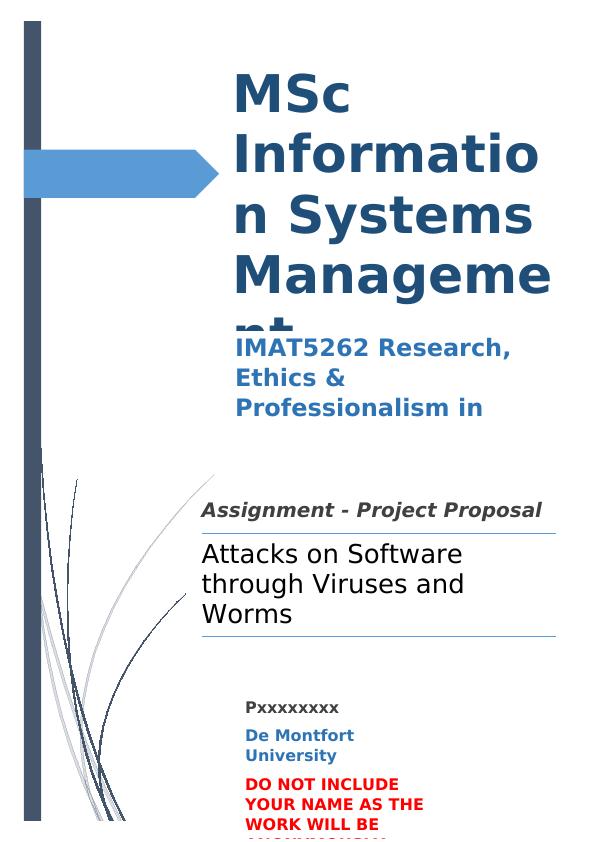
P Number: Pxxxxxxxx IMAT5262 Research, Ethics &
Professionalism in Computing
Abstract
In the present era of computer and communication technology, it has been observed that
computer security and privacy has been compromised over the last few years. Additionally,
the developments in the programming field have introduced a lot of expediencies to various
walks of life however they have as well produced cyber hackers and techniques to perform
computer related crimes at a great extent. In addition, at the present, computer viruses and
worms are considered as a very serious computer security threat. This report will present a
detailed overview of computer viruses and worms.
Key Words
Virus, Worm, Computer Crimes, ........
1
Professionalism in Computing
Abstract
In the present era of computer and communication technology, it has been observed that
computer security and privacy has been compromised over the last few years. Additionally,
the developments in the programming field have introduced a lot of expediencies to various
walks of life however they have as well produced cyber hackers and techniques to perform
computer related crimes at a great extent. In addition, at the present, computer viruses and
worms are considered as a very serious computer security threat. This report will present a
detailed overview of computer viruses and worms.
Key Words
Virus, Worm, Computer Crimes, ........
1
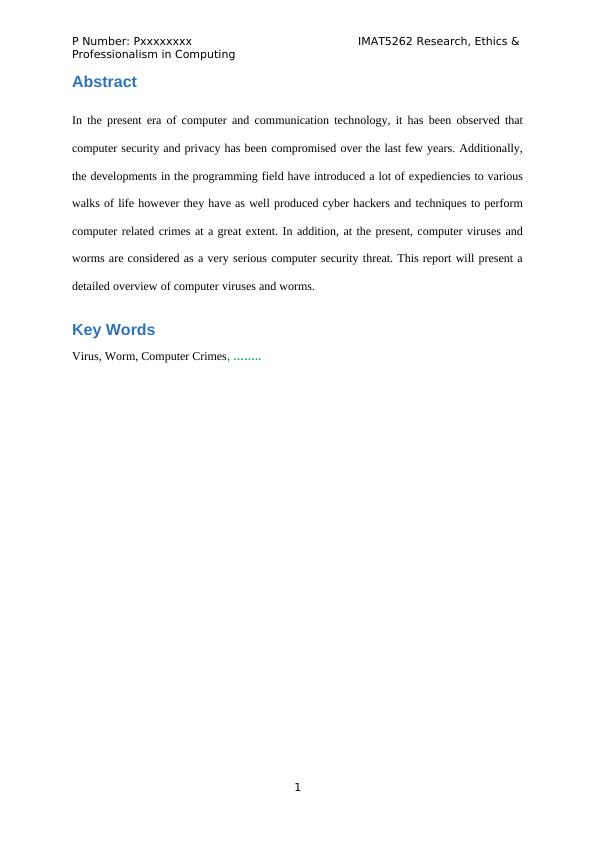
P Number: Pxxxxxxxx IMAT5262 Research, Ethics &
Professionalism in Computing
Table of Contents
1. Background...................................................................................................................3
2. Research questions......................................................................................................4
3. Literature Review.......................................................................................................... 4
3.1 Types of Computer Viruses...........................................................................................4
3.1.1 How virus spread.....................................................................................................5
3.1.2 Symptoms of Computer Virus................................................................................6
3.1.3 Methods of virus removal........................................................................................7
3.1.4 How to protect against virus...................................................................................7
3.2 Types of Computer Worms............................................................................................8
3.2.1 Harms of Computer Worms....................................................................................9
3.2.2 How to Protect Against Worms?............................................................................9
3.2.3 How to remove Computer Worm..........................................................................10
3.3 Difference between virus and worm...........................................................................10
4. Methodology Review...................................................................................................10
5. Conclusion................................................................................................................... 12
6. References................................................................................................................... 12
7. APPENDICES............................................................................................................... 13
Appendix (A): Project Plan................................................................................................13
Appendix (B): Ethical Review Form....................................................................................0
Appendix (C): Consent Form...............................................................................................5
Appendix (D): Pilot study.....................................................................................................7
2
Professionalism in Computing
Table of Contents
1. Background...................................................................................................................3
2. Research questions......................................................................................................4
3. Literature Review.......................................................................................................... 4
3.1 Types of Computer Viruses...........................................................................................4
3.1.1 How virus spread.....................................................................................................5
3.1.2 Symptoms of Computer Virus................................................................................6
3.1.3 Methods of virus removal........................................................................................7
3.1.4 How to protect against virus...................................................................................7
3.2 Types of Computer Worms............................................................................................8
3.2.1 Harms of Computer Worms....................................................................................9
3.2.2 How to Protect Against Worms?............................................................................9
3.2.3 How to remove Computer Worm..........................................................................10
3.3 Difference between virus and worm...........................................................................10
4. Methodology Review...................................................................................................10
5. Conclusion................................................................................................................... 12
6. References................................................................................................................... 12
7. APPENDICES............................................................................................................... 13
Appendix (A): Project Plan................................................................................................13
Appendix (B): Ethical Review Form....................................................................................0
Appendix (C): Consent Form...............................................................................................5
Appendix (D): Pilot study.....................................................................................................7
2
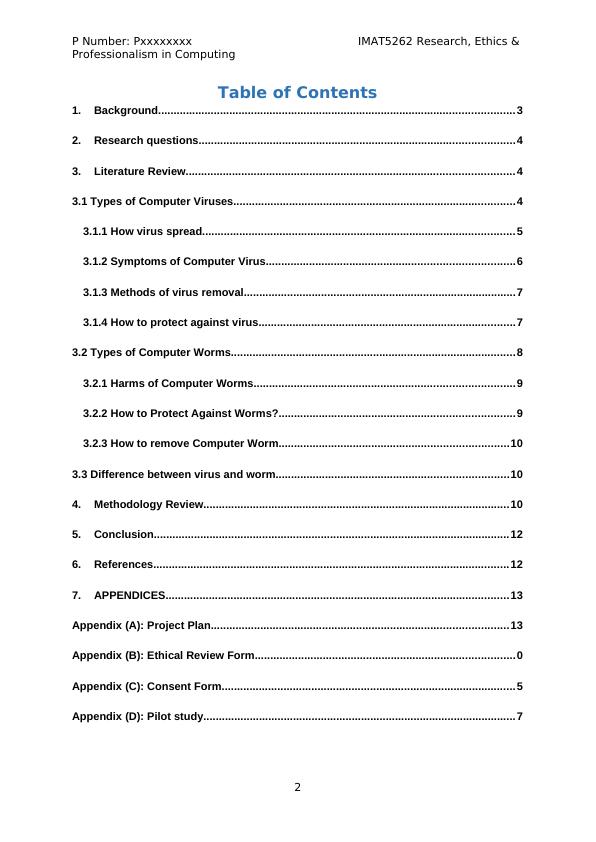
P Number: Pxxxxxxxx IMAT5262 Research, Ethics &
Professionalism in Computing
1. Background
A virus is a computer program that affects other computer programs by replicating itself.
Additionally, a virus has the capability to duplicate itself by activation, with the intention that
it is able to grow, always looking for latest host platforms. The majority risk-free viruses
carry out operation in a way that they make their copies as well as extend to more computers.
In addition, a computer virus code may perhaps affect additional computer software or it can
totally change the data, conceivably self-devastating as performed. However, the only proof
computer virus similar to this is the devastation they have caused on the affected PCs. Just
because of this capability it becomes extremely hard to offer protection beside virus
programs.
Moreover, during the last few decades, it is observed that computer viruses have been in
action with the development of computer technology. A virus is perceived as “a self-copying
computer code or program which multiplies by copying it into further documents or .exe
files.” Similar to an actual virus, a computer virus changes the system of an available
computer program to “control” it as well as starts its replication. Frequently computer viruses
have a special task or attention, for example removing definite data files or causing harm to a
computer system.
A computer worm is a type of infection which has the capability to extend itself to one or
more computer systems with no need to be transmitted as an element of a host message.
Additionally, a computer worm has the potential to destroy the hosted data on a computer,
practical performance, or affect network utilization, at the moment it gets run. In most cases a
worm does not really damage either the computer programs or hardware, as a minimum in
assumption. In addition, at the present, mostly PCs are linked to the local area networks and
web based technology like internet, helping the distribution of wicked programs. In addition,
3
Professionalism in Computing
1. Background
A virus is a computer program that affects other computer programs by replicating itself.
Additionally, a virus has the capability to duplicate itself by activation, with the intention that
it is able to grow, always looking for latest host platforms. The majority risk-free viruses
carry out operation in a way that they make their copies as well as extend to more computers.
In addition, a computer virus code may perhaps affect additional computer software or it can
totally change the data, conceivably self-devastating as performed. However, the only proof
computer virus similar to this is the devastation they have caused on the affected PCs. Just
because of this capability it becomes extremely hard to offer protection beside virus
programs.
Moreover, during the last few decades, it is observed that computer viruses have been in
action with the development of computer technology. A virus is perceived as “a self-copying
computer code or program which multiplies by copying it into further documents or .exe
files.” Similar to an actual virus, a computer virus changes the system of an available
computer program to “control” it as well as starts its replication. Frequently computer viruses
have a special task or attention, for example removing definite data files or causing harm to a
computer system.
A computer worm is a type of infection which has the capability to extend itself to one or
more computer systems with no need to be transmitted as an element of a host message.
Additionally, a computer worm has the potential to destroy the hosted data on a computer,
practical performance, or affect network utilization, at the moment it gets run. In most cases a
worm does not really damage either the computer programs or hardware, as a minimum in
assumption. In addition, at the present, mostly PCs are linked to the local area networks and
web based technology like internet, helping the distribution of wicked programs. In addition,
3
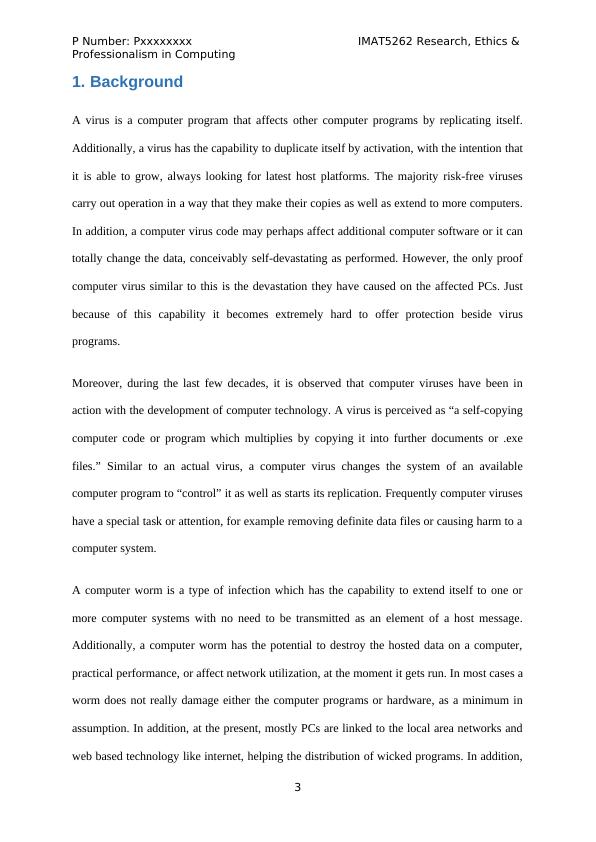
P Number: Pxxxxxxxx IMAT5262 Research, Ethics &
Professionalism in Computing
a number of sources utilize a substitute term in which a virus is declared as some type of self-
duplicating malware program. Most well-known examples of worms comprise Melissa,
Sobig, ILoveYou, Sasser and MyDoom worm.
2. Research questions
(i) What are the different types of computer viruses and worms?
(ii) How do we protect our computers, networks or systems from computer viruses
and worms?
(iii) How do we remove viruses and worms from infected computers, networks and
systems?
3. Literature Review
3.1 Types of Computer Viruses
There are many types of viruses, some of which comprise:
Polymorphic viruses: Polymorphic viruses alter their form with every attack. Additionally,
these types of encrypted viruses are typically hard to perceive as they are superior at
concealing themselves from anti-virus programs (Conklin,arthur et al., 2018).
Boot Sector Viruses: These viruses are the oldest kind of virus. The influence of these
viruses is observed on startup programs of computer and the virus activates itself with the
startup of computer. Boot sector viruses are the type of viruses that spoil the boot sector
(known as master boot record) of an infected system. These viruses initially change or over-
write the actual boot code, by swapping it with devastated boot code. They will then move
the actual boot sector data to an additional hard disk sector, then declaring that particular disk
sector like a spoiled mark on the storage disk with the intention that it will become useless for
future (Conklin, White, Williams, Davis, & Cothren, 2016).
4
Professionalism in Computing
a number of sources utilize a substitute term in which a virus is declared as some type of self-
duplicating malware program. Most well-known examples of worms comprise Melissa,
Sobig, ILoveYou, Sasser and MyDoom worm.
2. Research questions
(i) What are the different types of computer viruses and worms?
(ii) How do we protect our computers, networks or systems from computer viruses
and worms?
(iii) How do we remove viruses and worms from infected computers, networks and
systems?
3. Literature Review
3.1 Types of Computer Viruses
There are many types of viruses, some of which comprise:
Polymorphic viruses: Polymorphic viruses alter their form with every attack. Additionally,
these types of encrypted viruses are typically hard to perceive as they are superior at
concealing themselves from anti-virus programs (Conklin,arthur et al., 2018).
Boot Sector Viruses: These viruses are the oldest kind of virus. The influence of these
viruses is observed on startup programs of computer and the virus activates itself with the
startup of computer. Boot sector viruses are the type of viruses that spoil the boot sector
(known as master boot record) of an infected system. These viruses initially change or over-
write the actual boot code, by swapping it with devastated boot code. They will then move
the actual boot sector data to an additional hard disk sector, then declaring that particular disk
sector like a spoiled mark on the storage disk with the intention that it will become useless for
future (Conklin, White, Williams, Davis, & Cothren, 2016).
4
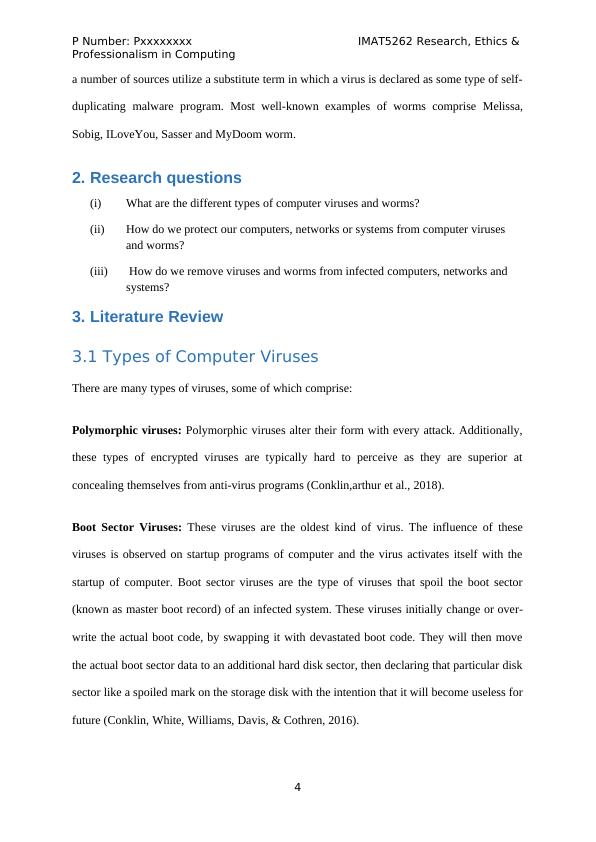
P Number: Pxxxxxxxx IMAT5262 Research, Ethics &
Professionalism in Computing
Macro Viruses: This kind of viruses utilizes commands known as macros those are fixed in
further computer programs to cause harm and extend to additional related files used by that
definite computer program. For example Microsoft applications such as Word and Excel use
macros, and macros viruses are able to grow through the utilization of these certain
commands.
File Viruses: File viruses have the capability to join themselves to further computer software
programs. As the program is executed, the file virus makes its way to the memory locations
so that it could be able to affect other executable files or start destructing the computer
system (Easttom & Taylor, 2011).
Multi-partite viruses: These viruses affect both .exe files and boot sector of hard disk. They
are the nastiest types of viruses since they are able to merge a few or all of stealth virus
methodologies, through polymorphism practice to avert its exposure to various antivirus
programs.
Stealth viruses: These types of viruses try to conceal from both the operating system
capabilities and antivirus program. However, to perform this activity, they have to reside in
computer memory so that they could be able to interrupt every effort to employ the operating
system (Easttom, 2016). Additionally, a stealth virus is able to conceal alterations it usually
creates to directory framework, file sizes, and further features related to an operating system.
Because portion of the virus stays in memory, resultantly users will experience less memory
usage.
3.1.1 How virus spread
Few cases which spread viruses are:
5
Professionalism in Computing
Macro Viruses: This kind of viruses utilizes commands known as macros those are fixed in
further computer programs to cause harm and extend to additional related files used by that
definite computer program. For example Microsoft applications such as Word and Excel use
macros, and macros viruses are able to grow through the utilization of these certain
commands.
File Viruses: File viruses have the capability to join themselves to further computer software
programs. As the program is executed, the file virus makes its way to the memory locations
so that it could be able to affect other executable files or start destructing the computer
system (Easttom & Taylor, 2011).
Multi-partite viruses: These viruses affect both .exe files and boot sector of hard disk. They
are the nastiest types of viruses since they are able to merge a few or all of stealth virus
methodologies, through polymorphism practice to avert its exposure to various antivirus
programs.
Stealth viruses: These types of viruses try to conceal from both the operating system
capabilities and antivirus program. However, to perform this activity, they have to reside in
computer memory so that they could be able to interrupt every effort to employ the operating
system (Easttom, 2016). Additionally, a stealth virus is able to conceal alterations it usually
creates to directory framework, file sizes, and further features related to an operating system.
Because portion of the virus stays in memory, resultantly users will experience less memory
usage.
3.1.1 How virus spread
Few cases which spread viruses are:
5
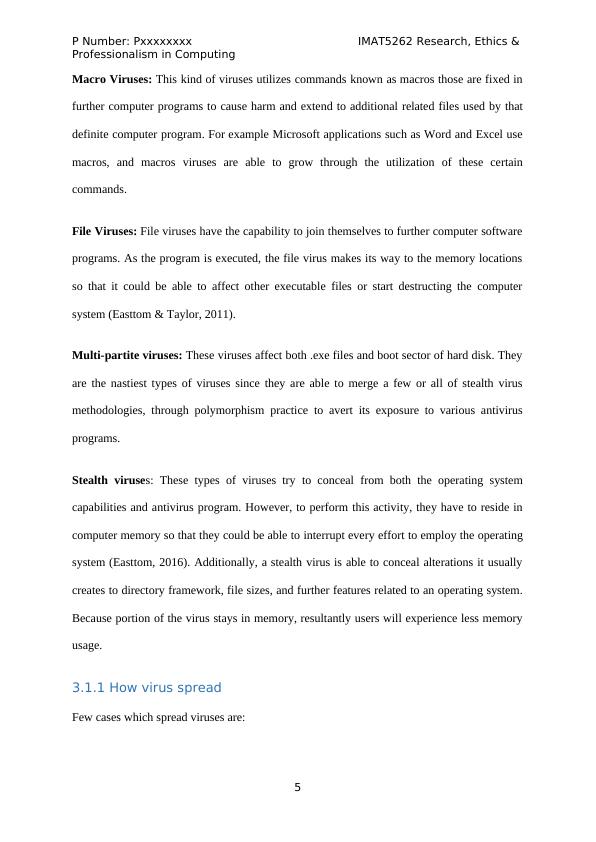
End of preview
Want to access all the pages? Upload your documents or become a member.
Related Documents
IMAT5262: Research, Ethics & Professionalism in Computinglg...
|29
|4575
|98
IMAT5262 : Research, Ethics & Professionalism in Computinglg...
|25
|4532
|88
IMAT5262 Research, Ethics & Professionalism in Computinglg...
|25
|3691
|112
Ethical and Moral Dilemmas of Computing Professionalslg...
|18
|4270
|86
Exploring the Role of Ethics in Shaping Professional Responsibilities of ICT Professionalslg...
|25
|5122
|448
Research Proposal on AI and Roboticslg...
|22
|4112
|312
